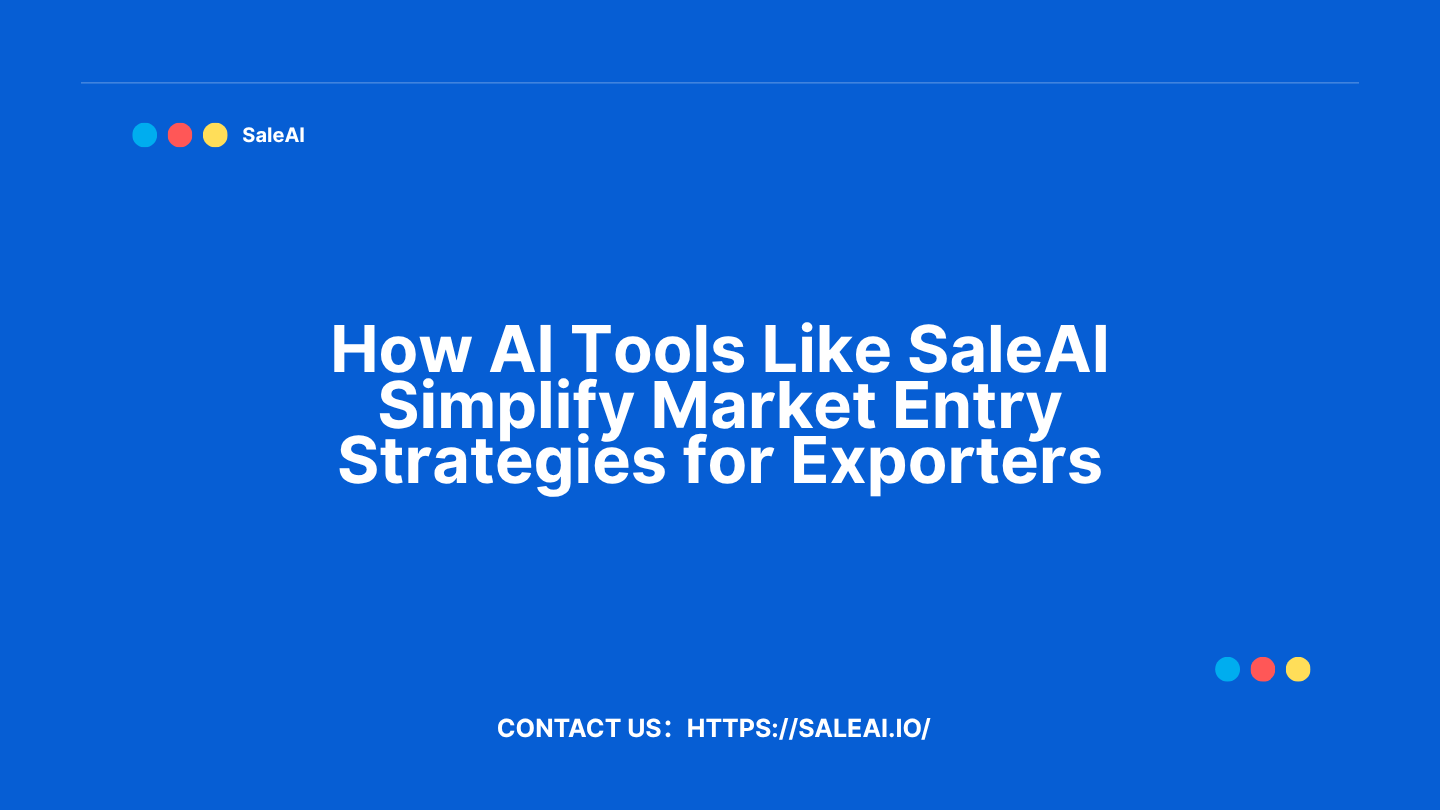
Introduction: The Challenges of Market Entry for Exporters
Entering a new market is one of the most complex yet rewarding growth strategies for exporters. From understanding local demand to identifying reliable buyers, the process involves numerous decisions, often based on incomplete or outdated information. Traditional market entry strategies, while effective in the past, are no longer sufficient in today’s fast-evolving global trade landscape.
This is where AI-powered tools like SaleAI come in. By leveraging artificial intelligence, exporters can:
- Analyze market potential with data-driven insi
- ghts.
- Identify high-potential buyers in target regions.
- Predict trends and mitigate risks before entering a new market.
In this article, we’ll explore how AI tools simplify the market entry process, enabling exporters to make smarter, faster, and more confident decisions.
Section 1: What Is an AI-Driven Market Entry Strategy?
An AI-driven market entry strategy leverages artificial intelligence to analyze trade data, buyer behavior, and market trends. Unlike traditional approaches that rely heavily on manual research and assumptions, AI tools provide:
- Real-Time Insights: Access up-to-date market data to guide decision-making.
- Predictive Analytics: Forecast demand and identify emerging opportunities.
- Targeted Lead Discovery: Focus on verified buyers with proven transaction histories.
For exporters, this means reduced risk, faster market penetration, and improved ROI.
Section 2: The Role of SaleAI in Market Entry Strategies
a. Market Potential Analysis
Before entering a new market, exporters need to understand its trade dynamics. SaleAI provides:
- Customs Data Insights: Analyze import volumes, HS codes, and transaction sizes for your product category.
- Regional Demand Trends: Identify countries with growing demand for your products.
- Competitor Benchmarking: Compare your presence with competitors to find untapped opportunities.
Application Example:
A furniture exporter used SaleAI to identify high-demand regions in the Middle East for eco-friendly furniture, aligning their strategy with market preferences.
b. Verified Buyer Identification
Finding reliable buyers is critical for market entry. SaleAI helps exporters:
- Filter buyers based on product categories and transaction histories.
- Evaluate buyer activity (e.g., frequency, volume, and reliability).
- Segment buyers by region, industry, or company size.
By focusing on verified buyers, exporters can minimize risks and improve their chances of successful market entry.
c. Risk Mitigation with Predictive Analytics
SaleAI’s predictive capabilities allow exporters to anticipate challenges and adjust strategies accordingly. For example:
- Economic Trends: Monitor macroeconomic indicators that may impact demand.
- Regulatory Insights: Stay updated on trade policies, tariffs, and compliance requirements.
- Competitor Movements: Track shifts in competitor activities to adapt your approach.
Pro Tip: Use predictive analytics to time your entry during periods of peak demand or reduced competition.
d. Multi-Channel Outreach Automation
Once a target market is identified, engaging potential buyers becomes the next challenge. SaleAI’s outreach tools enable exporters to:
- Automate email and WhatsApp campaigns with personalized messages.
- Engage buyers on LinkedIn to build professional relationships.
- Track engagement metrics to refine communication strategies.
This ensures consistent and effective communication during the critical early stages of market entry.
Section 3: The Benefits of AI-Driven Market Entry Strategies
-
Data-Driven Decision-Making:
- Replace assumptions with actionable insights derived from real data.
-
Faster Market Penetration:
- Use AI tools to identify and engage buyers quickly, reducing time-to-market.
-
Reduced Risk:
- Mitigate risks by analyzing economic, regulatory, and competitive factors before entering a market.
-
Improved ROI:
- Focus resources on high-potential buyers and markets for maximum impact.
-
Scalability:
- Explore multiple markets simultaneously without additional manpower.
Section 4: Step-by-Step Guide to Using SaleAI for Market Entry
Step 1: Define Your Target Market
- Select regions or countries based on trade data and product demand.
- Use SaleAI’s HS code filters to align with your product category.
Step 2: Analyze Market Potential
- Review import volumes, seasonal trends, and competitive activity.
- Identify key growth indicators, such as rising demand or favorable trade policies.
Step 3: Identify Verified Buyers
- Use SaleAI to filter buyers by region, industry, and transaction history.
- Focus on reliable buyers with consistent import activity.
Step 4: Develop an Outreach Plan
- Segment buyers into categories (e.g., high-potential, medium-priority).
- Create personalized email and messaging campaigns for each segment.
Step 5: Monitor and Optimize
- Track engagement metrics (e.g., open rates, replies, conversions).
- Use insights from SaleAI’s dashboard to refine your approach.
Section 5: Realistic Applications of AI-Driven Market Entry
a. Expanding to High-Growth Markets
An electronics exporter analyzed SaleAI’s trade data to identify Southeast Asia as a high-potential region for consumer electronics. By targeting verified buyers and timing their entry during a demand surge, they successfully established a foothold in the market.
b. Mitigating Risks in New Regions
A chemical exporter used SaleAI to monitor regulatory changes in South America. This allowed them to adjust their pricing and documentation processes, avoiding potential compliance issues.
c. Streamlining Buyer Engagement
After identifying verified buyers in Europe, an exporter of industrial machinery used SaleAI’s outreach tools to automate follow-ups, ensuring timely communication with all potential clients.
Section 6: Overcoming Common Market Entry Challenges
-
Identifying Reliable Buyers:
- Solution: Use SaleAI’s verified buyer filters to focus on companies with proven track records.
-
Understanding Local Demand:
- Solution: Analyze customs data and market trends to align products with regional preferences.
-
Navigating Regulatory Hurdles:
- Solution: Stay updated on trade policies and compliance requirements using SaleAI’s insights.
-
Managing Competition:
- Solution: Monitor competitor activities and adapt your strategy to target underserved markets.
Conclusion: Transform Your Market Entry Strategy with SaleAI
Entering a new market is a significant milestone for any exporter, but it doesn’t have to be overwhelming. With AI tools like SaleAI, you can:
- Make data-informed decisions with confidence.
- Identify high-potential buyers in less time.
- Mitigate risks and adapt to changing market conditions.
Whether you’re expanding into a neighboring country or venturing into a new continent, SaleAI provides the tools and insights you need to succeed.
Start your free trial with SaleAI today and redefine the way you approach market entry.


